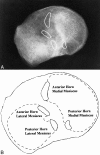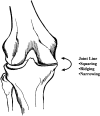The meniscus: review of basic principles with application to surgery and rehabilitation
- PMID: 16558666
- PMCID: PMC155528
The meniscus: review of basic principles with application to surgery and rehabilitation
Abstract
Objective: To review basic meniscal anatomy, histology, and biomechanical principles as they apply to surgery and rehabilitation.
Data sources: We searched MEDLINE and CINAHL for the years 1960-1999 using the terms meniscus,surgery,rehabilitation,meniscal repair, and arthroscopy.
Data synthesis: Injuries to a healthy meniscus are usually produced by a compressive force coupled with transverse-plane tibiofemoral rotation as the knee moves from flexion to extension during rapid cutting or pivoting. The goal of meniscal surgery is to restore a functional meniscus to prevent the development of degenerative osteoarthritis in the involved knee. The goal of rehabilitation is to restore patient function based on individual needs, considering the type of surgical procedure, which meniscus was repaired, the presence of coexisting knee pathology (particularly ligamentous laxity or articular cartilage degeneration), the type of meniscal tear, the patient's age, preoperative knee status (including time between injury and surgery), decreased range of motion or strength, and the patient's athletic expectations and motivations. Progressive weight bearing and joint stress are necessary to enhance the functionality of the meniscal repair; however, excessive shear forces may be disruptive. Prolonged knee immobilization after surgery can result in the rapid development of muscular atrophy and greater delays in functional recovery.
Conclusions/recommendations: Accelerated joint mobility and weight-bearing components of rehabilitation protocols represent the confidence placed in innovative surgical fixation methods. After wound healing, an aquatic therapy environment may be ideal during all phases of rehabilitation after meniscal surgery (regardless of the exact procedure), providing the advantages of controlled weight bearing and mobility progressions. Well-designed, controlled, longitudinal outcome studies for patients who have undergone meniscectomy, meniscal repair, or meniscal reconstruction are lacking.
Figures






References
-
- National high school injury survey. Natl Athl Train Assoc News. 1996 Apr;:17–23.
-
- Rice SG. Risks of injury during sports participation. In: Sullivan JA, Anderson SJ, editors. Care of the Young Athlete. Rosemont, IL: American Academy of Orthopaedic Surgeons and the American Academy of Pediatrics; 2000. pp. 9–18.
-
- Stocker B, Nyland J, Caborn D, Sternes R, Ray JM. Results of Kentucky high school football knee injury survey. J Ky Med Assoc. 1997;95:458–464. - PubMed
-
- Wheatley WB, Krome J, Martin DF. Rehabilitation programmes following arthroscopic meniscectomy in athletes. Sports Med. 1996;21:447–456. - PubMed
-
- O'Donoghue DH. Surgical treatment of fresh injuries to the major ligaments of the knee [classical article] 1950. Clin Orthop. 1991;271:3–8. - PubMed
LinkOut - more resources
Full Text Sources
Other Literature Sources
